| Listing 1 - 10 of 15 | << page >> |
Sort by
|
Book

Year: 2020 Publisher: Frontiers Media SA
Abstract | Keywords | Export | Availability | Bookmark
 Loading...
Loading...Choose an application
- Reference Manager
- EndNote
- RefWorks (Direct export to RefWorks)
The physics of porous media is, when taking a broad view, the physics of multinary mixtures of immiscible solid and fluid constituents. Its relevance to society echoes in numerous engineering disciplines such as chemical engineering, soil mechanics, petroleum engineering, groundwater engineering, geothermics, fuel cell technology… It is also at the core of many scientific disciplines ranging from hydrogeology to pulmonology. Perhaps one may affix a starting point for the study of porous media as the year 1794 when Reinhard Woltman introduced the concept of volume fractions when trying to understand mud. In 1856, Henry Darcy published his findings on the flow of water through sand packed columns and the first constitutive relation was born. Wyckoff and Botset proposed in 1936 a generalization of the Darcy approach to deal with several immiscible fluids flowing simultaneously in a rigid matrix. This effective medium theory assigns to each fluid a relative permeability, i.e. a constitutive law for each fluid species. It remains to this day the standard framework for handling the motion of two or more immiscible fluids in a rigid porous matrix even though there have been many attempts at moving beyond it. When the solid constituent is not rigid, forces in the fluids and the solid phase influence each other. von Terzaghi realized the importance of capillary forces in such systems in the thirties. An effective medium theory of poroelasticity was subsequently developend by Biot in the mid fifties. Biot theory remains to date state of the art for handling matrix-fluid interactions when the deformations of the solid phase remain small. For large deformations, e.g. when the solid phase is unconsolidated, no effective medium theory exists.
Book

Year: 2020 Publisher: Frontiers Media SA
Abstract | Keywords | Export | Availability | Bookmark
 Loading...
Loading...Choose an application
- Reference Manager
- EndNote
- RefWorks (Direct export to RefWorks)
The physics of porous media is, when taking a broad view, the physics of multinary mixtures of immiscible solid and fluid constituents. Its relevance to society echoes in numerous engineering disciplines such as chemical engineering, soil mechanics, petroleum engineering, groundwater engineering, geothermics, fuel cell technology… It is also at the core of many scientific disciplines ranging from hydrogeology to pulmonology. Perhaps one may affix a starting point for the study of porous media as the year 1794 when Reinhard Woltman introduced the concept of volume fractions when trying to understand mud. In 1856, Henry Darcy published his findings on the flow of water through sand packed columns and the first constitutive relation was born. Wyckoff and Botset proposed in 1936 a generalization of the Darcy approach to deal with several immiscible fluids flowing simultaneously in a rigid matrix. This effective medium theory assigns to each fluid a relative permeability, i.e. a constitutive law for each fluid species. It remains to this day the standard framework for handling the motion of two or more immiscible fluids in a rigid porous matrix even though there have been many attempts at moving beyond it. When the solid constituent is not rigid, forces in the fluids and the solid phase influence each other. von Terzaghi realized the importance of capillary forces in such systems in the thirties. An effective medium theory of poroelasticity was subsequently developend by Biot in the mid fifties. Biot theory remains to date state of the art for handling matrix-fluid interactions when the deformations of the solid phase remain small. For large deformations, e.g. when the solid phase is unconsolidated, no effective medium theory exists.
Science: general issues --- Physics --- flow in porous media --- two-phase flow in porous media --- non-Newtonian fluids --- reactive fluids --- electrohydrodynamics (EHD) --- capillary fiber bundle model --- soil mechanics --- thermodynamics of small systems --- flow in porous media --- two-phase flow in porous media --- non-Newtonian fluids --- reactive fluids --- electrohydrodynamics (EHD) --- capillary fiber bundle model --- soil mechanics --- thermodynamics of small systems
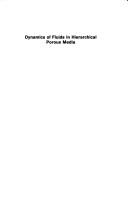
ISBN: 0122002601 Year: 1990 Publisher: London Academic press
Abstract | Keywords | Export | Availability | Bookmark
 Loading...
Loading...Choose an application
- Reference Manager
- EndNote
- RefWorks (Direct export to RefWorks)
Fluid dynamics --- Groundwater flow --- Porous materials --- Fluides, Dynamique des --- Eau souterraine --- Matériaux poreux --- Ecoulement --- 532.546 --- In porous media --- Fluids --- Transport phenomena --- 532.546 In porous media --- Matériaux poreux --- Groundwater flow.
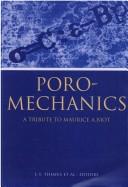
ISBN: 9058090035 9789058090034 Year: 1998 Publisher: Rotterdam : A.A. Balkema,
Abstract | Keywords | Export | Availability | Bookmark
 Loading...
Loading...Choose an application
- Reference Manager
- EndNote
- RefWorks (Direct export to RefWorks)
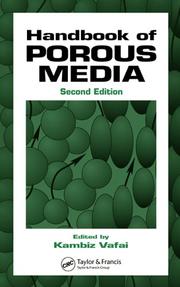
ISBN: 0824727479 Year: 2005 Publisher: Boca Raton Taylor & Francis
Abstract | Keywords | Export | Availability | Bookmark
 Loading...
Loading...Choose an application
- Reference Manager
- EndNote
- RefWorks (Direct export to RefWorks)
Porous materials --- 532.546 --- 62-405.8 --- In porous media --- Porous. Cellular. Sponge-like --- 62-405.8 Porous. Cellular. Sponge-like --- 532.546 In porous media --- Porous media --- Materials --- Porosity
Book

Year: 2020 Publisher: Frontiers Media SA
Abstract | Keywords | Export | Availability | Bookmark
 Loading...
Loading...Choose an application
- Reference Manager
- EndNote
- RefWorks (Direct export to RefWorks)
The physics of porous media is, when taking a broad view, the physics of multinary mixtures of immiscible solid and fluid constituents. Its relevance to society echoes in numerous engineering disciplines such as chemical engineering, soil mechanics, petroleum engineering, groundwater engineering, geothermics, fuel cell technology… It is also at the core of many scientific disciplines ranging from hydrogeology to pulmonology. Perhaps one may affix a starting point for the study of porous media as the year 1794 when Reinhard Woltman introduced the concept of volume fractions when trying to understand mud. In 1856, Henry Darcy published his findings on the flow of water through sand packed columns and the first constitutive relation was born. Wyckoff and Botset proposed in 1936 a generalization of the Darcy approach to deal with several immiscible fluids flowing simultaneously in a rigid matrix. This effective medium theory assigns to each fluid a relative permeability, i.e. a constitutive law for each fluid species. It remains to this day the standard framework for handling the motion of two or more immiscible fluids in a rigid porous matrix even though there have been many attempts at moving beyond it. When the solid constituent is not rigid, forces in the fluids and the solid phase influence each other. von Terzaghi realized the importance of capillary forces in such systems in the thirties. An effective medium theory of poroelasticity was subsequently developend by Biot in the mid fifties. Biot theory remains to date state of the art for handling matrix-fluid interactions when the deformations of the solid phase remain small. For large deformations, e.g. when the solid phase is unconsolidated, no effective medium theory exists.
Science: general issues --- Physics --- flow in porous media --- two-phase flow in porous media --- non-Newtonian fluids --- reactive fluids --- electrohydrodynamics (EHD) --- capillary fiber bundle model --- soil mechanics --- thermodynamics of small systems
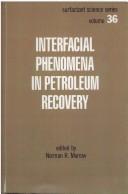
ISBN: 9780824783853 0824783859 Year: 1991 Publisher: New York Marcel Dekker
Abstract | Keywords | Export | Availability | Bookmark
 Loading...
Loading...Choose an application
- Reference Manager
- EndNote
- RefWorks (Direct export to RefWorks)
Oil fields - Production methods. --- Rocks - Permeability. --- Permeability of porous media --- Oil recovery in porous media --- Interface phenomena oil recovery --- Oil fields --- Rocks
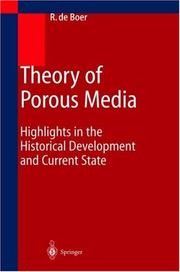
ISBN: 354065982X Year: 2000 Publisher: Berlin : Springer,
Abstract | Keywords | Export | Availability | Bookmark
 Loading...
Loading...Choose an application
- Reference Manager
- EndNote
- RefWorks (Direct export to RefWorks)
Porous materials --- 532.546 --- 539.217 --- 631.434 --- 631.434 Soil structure. Soil porosity --- Soil structure. Soil porosity --- 539.217 Porosity. Permeability. Imperviousness --- Porosity. Permeability. Imperviousness --- 532.546 In porous media --- In porous media --- Porous media --- Materials --- Porosity --- Mechanical properties --- Thermodynamics
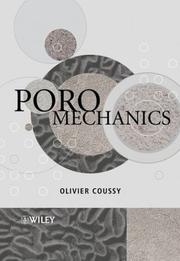
ISBN: 0470849207 9780470849200 Year: 2004 Publisher: New York, NY : John Wiley,
Abstract | Keywords | Export | Availability | Bookmark
 Loading...
Loading...Choose an application
- Reference Manager
- EndNote
- RefWorks (Direct export to RefWorks)
Porous materials --- Continuum mechanics --- Mechanical properties. --- Mechanical properties --- Mathematical models. --- 612.76 --- 539.217 --- 62-405.8 --- 532.546 --- Locomotie. Beweging. Lichaamsmechanica. Biomedische ingenieurstechnieken --- Porosity. Permeability. Imperviousness --- Porous. Cellular. Sponge-like --- In porous media --- Continuum mechanics. --- 532.546 In porous media --- 62-405.8 Porous. Cellular. Sponge-like --- 539.217 Porosity. Permeability. Imperviousness --- Porous media --- Materials --- Porosity --- Mechanics of continua --- Elasticity --- Mechanics, Analytic --- Field theory (Physics) --- Mechanical properties&delete& --- Mathematical models --- Porous materials - Mechanical properties. --- Porous materials - Mechanical properties - Mathematical models.
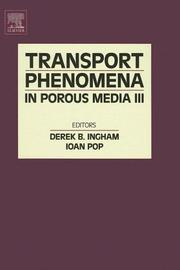
ISBN: 0080444903 9786611058791 1281058793 0080543189 Year: 2005 Publisher: Oxford : Elsevier,
Abstract | Keywords | Export | Availability | Bookmark
 Loading...
Loading...Choose an application
- Reference Manager
- EndNote
- RefWorks (Direct export to RefWorks)
Fluid and flow problems in porous media have attracted the attention of industrialists, engineers and scientists from varying disciplines, such as chemical, environmental, and mechanical engineering, geothermal physics and food science. There has been a increasing interest in heat and fluid flows through porous media, making this book a timely and appropriate resource.Each chapter is systematically detailed to be easily grasped by a research worker with basic knowledge of fluid mechanics, heat transfer and computational and experimental methods. At the same time, the readers will be in
532.546 --- 631.432.3 --- 664.8.036 --- In porous media --- Permeability. Lessivage. Leaching. Mobility of soil constituents --- Food preservation by heating --- 664.8.036 Food preservation by heating --- 631.432.3 Permeability. Lessivage. Leaching. Mobility of soil constituents --- 532.546 In porous media --- Transport theory. --- Porous materials. --- Porous materials --- Fluid mechanics. --- Hydromechanics --- Continuum mechanics --- Porous media --- Materials --- Porosity --- Boltzmann transport equation --- Transport phenomena --- Mathematical physics --- Particles (Nuclear physics) --- Radiation --- Statistical mechanics --- Thermal properties. --- Fluid dynamics.
| Listing 1 - 10 of 15 | << page >> |
Sort by
|

 Search
Search Feedback
Feedback About UniCat
About UniCat  Help
Help News
News